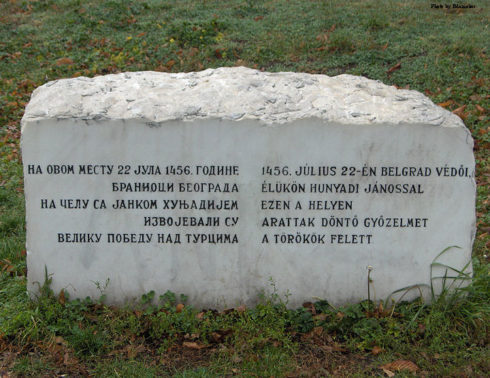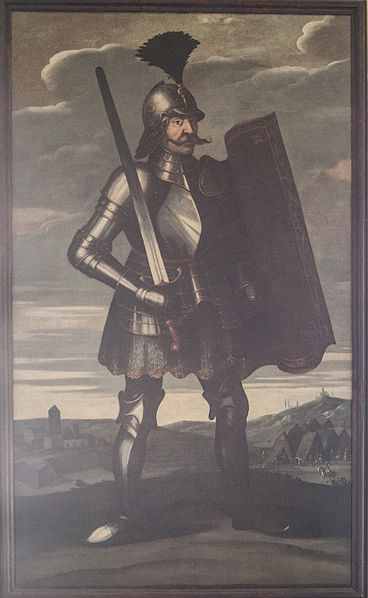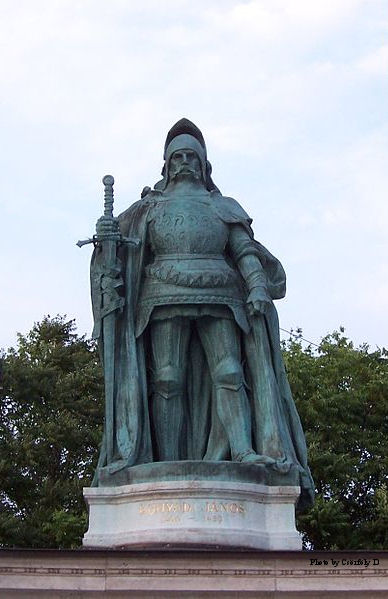(JOHN)
Governor of Hungary, born about 1400; died 11 August, 1456; the heroic defender of the Catholic Faith against the advance of the Osmanli; father of King Matthias I (Corvinus) of Hungary. The origin and parentage of his family was not ascertained until recently, when modern investigation cleared up the numerous legends which surrounded the Hunyadi family. The historian Bonfini derived the family from the Roman gens Corvina, or Valeriana, in order to flatter his king, Matthias Corvinus. Gáspár Heltai in his chronicle makes Hunyady the illegitimate son of King Sigismund and a Wallachian peasant-girl. Others try to establish the purely Hungarian origin of the family; others again put in a plea for its Serb or Wallachian origin. In view of modern investigations it may be taken as proved that the family of Hunyadi was of Rumanian origin; János Hunyady himself, however, may be regarded as a Hungarian from his birthplace; probably he spoke the Wallachian language only during his youth, and no doubt was born in the Catholic faith, which his father Vajk (Voik, Vuk) probably had already professed. The oldest ascertained member of the family was called Serbe, whose son, Vajk, the father of János Hunyady, was already in possession of the hereditary seat of the family, the castle Hunyad, before 1407. The parentage of the mother of Hunyady underwent an exhaustive scrutiny at the hands of modern critics. While formerly his mother, Elizabeth, was supposed to belong to the family of Morzsinay, it was recently shown by János Karácsonyi, that for various reasons the marriage of Hunyady’s father with a member of the family of Morzsinay is inadmissible. However, the name of Hunyady’s mother has not been ascertained up to the present time. The year of Hunyady’s birth is either one of the last years of the fourteenth, or one of the first years of the fifteenth century. According to Count Joseph Teleki, the historian of the House of Hunyady, he was born in 1387. The birthplace of Hunyady is equally unknown.
Of his youth we know that in 1410-4 he was in the service of the family Ujlaky, in the southern part of the country, in Syrmia or in the Banat of Macsó. In 1414-27 he was in the service of the despot, Stefan Lazarevics of Servia, in one of whose Hungarian fortresses (perhaps Becse), he was stationed. We find him in the military entourage of the King Sigismund and Albrecht, 1428-39. Sigismund rewarded Hunyady, who distinguished himself in the war against the Turks, during the siege of the castle of Szendrö, with large donations and made him one of his counsellors. The rise to power of Hunyady began after the death of Sigismund. In 1438, King Albert appointed him Ban of Szörény (Severin) and Count of Temes, in 1439 he received from the king another donation and the castle of Hunyad (his family seat), and was named as guardian of Albert’s posthumous son, Ladislaus.  After the death of Albert, Wladislaw III of Poland was elected King of Hungary, in order to give the country a strong ruler; Hunyady took a leading part in this election. By his support the new king firmly established himself on the throne. Through gratitude he made Hunyady commander of the fortress of Belgrade, and Voivode of Transylvania. This appointment was the beginning of the great wars, under Hunyady’s leadership, against the Turks, who were threatening Hungary. In 1441 he gained the victory of Szendrö, in 1422 that of Maros-Szent-Imre, whereupon he invaded and conquered Wallachia. In 1443 Hunyady began the Bulgarian war, during which he advanced to Sofia, and captured it. The sultan was forced to make peace in 1444. At the instigation of the papal legate, Cardinal Julian Cesarini, King Ladislaus I broke the peace and decided on a new campaign against the Turks. On 10 Nov., 1444, the Hungarian army was defeated at Varna, and the king himself met his death on the battlefield. After the battle, Hunyady fled, and fell into the hands of Drakus, Voivode of the Wallachians; however, he soon obtained his freedom. In 1445, the diet elected Hunyady one of the five governors of the country, and placed him over Transylvania and the districts beyond the Theiss.
After the death of Albert, Wladislaw III of Poland was elected King of Hungary, in order to give the country a strong ruler; Hunyady took a leading part in this election. By his support the new king firmly established himself on the throne. Through gratitude he made Hunyady commander of the fortress of Belgrade, and Voivode of Transylvania. This appointment was the beginning of the great wars, under Hunyady’s leadership, against the Turks, who were threatening Hungary. In 1441 he gained the victory of Szendrö, in 1422 that of Maros-Szent-Imre, whereupon he invaded and conquered Wallachia. In 1443 Hunyady began the Bulgarian war, during which he advanced to Sofia, and captured it. The sultan was forced to make peace in 1444. At the instigation of the papal legate, Cardinal Julian Cesarini, King Ladislaus I broke the peace and decided on a new campaign against the Turks. On 10 Nov., 1444, the Hungarian army was defeated at Varna, and the king himself met his death on the battlefield. After the battle, Hunyady fled, and fell into the hands of Drakus, Voivode of the Wallachians; however, he soon obtained his freedom. In 1445, the diet elected Hunyady one of the five governors of the country, and placed him over Transylvania and the districts beyond the Theiss.
In 1446, Hunyady was elected Governor of Hungary, and entrusted with its government in the name of the minor, Ladislaus V, until the latter’s majority. The years 1446-8 were taken up with a war against Emperor Frederick III, who was ravaging the western part of Hungary, and with campaigns against the Turks. On 17-19 Oct., 1448, occurred the battle of the Amselfelde (Kossovo Heath, in Servia), against the Turks, which ended in Hunyady’s defeat. While fleeing, Hunyady fell into the hands of his deadly enemy the despot, Georg Brankovics of Servia; however, he soon succeeded in regaining his freedom through the intervention of the Hungarian magnates. Thereupon Hunyady turned his attention to the Hussites, who, under the leadership of John Ziska, were devastating the upper part of the country. In 1450, he made warlike preparations against the despot, Georg Brankovics, but they came to a mutual agreement. As governor, Hunyady conducted the negotiations with the Emperor Frederick, the guardian of King Ladislaus, to enable the latter to go to Hungary. Ladislaus remained with the emperor, but the emperor recognized Hunyady as governor. In 1453, when Ladislaus came to the throne, Hunyady resigned as governor, and was appointed Captain-General of Hungary, and Count of Besztercze.

Stone in the Kalemegdan park, in Belgrade, with engraved inscription on the place where Catholic forces under command of Yanosh Huniady won the battle against the Turks in the year 1456.
The last years of Hunyady’s life were taken up with new campaigns against the Turks. In 1451, Sultan Mohammed II armed himself for a decisive campaign against Europe, conquered Constantinople in 1453 and then prepared for war against Hungary. In 1454, Servia fell into the hands of the Turks, but Hunyady gained a victory over them at Szendrö. The wiles and intrigues of his hereditary enemy, Ulric Czilley, caused Hunyady to resign all his dignities, and to retire into private life; but as the power of the Osmanli became more threatening, Hunyady came forward once more, reconciled himself with Czilley, and undertook the defence of the southern frontier of Hungary. After the preparations for war had been completed with all speed, Hunyady marshalled his army, united with the peasant forces of the Franciscan monk, John Capistran at Szeged, and set out against Sultan Mohammed. At Belgrade he gained a brilliant victory over the Turks, 21-22 July, 1456, but he survived this victory only a short time. The plague, which had broken out in the camp of the Christian army, carried him off. According to his wish, his body was buried at Gyulafejérvár.

Corvin Castle, also known as Hunyad Castle, in Romania. Sigismund, King of Hungary bestowed Hunyad Castle and the lands attached to it upon John’s father, Voyk and Voyk’s four kinsmen, including John himself. Photo by Lupu Radu.
Hunyady was married to Elizabeth Szilágyi, of Horogssey. Of the male issue of this marriage, Ladislaus, who was concerned in a conspiracy against King Ladislaus V, fell under the headman’s axe, 16 March, 1457, at Buda. The second son, Matthias, succeeded to the Hungarian throne in 1458 at the death of Ladislaus V.
In Hungarian: – TELEKI, Hudnyaiak kora Magyarországon (The Age of Hunyady in Hungary). I-VI, X-XII (1852-7), and as continuation, the work of CZÁNKI, Die historische Geographie Ungarns in Zeitalter des Hunyady’s. Also vol. IV of the great Geschichte Ungarns, ed. SZILAGYI (Budapest, 1890); PÓR, Johann Hunyady (Budapest, 1873). On the origin of the family, the treatises of RÉTHY, CSÁNKI and KARÁCSONYI in Turul in the course of the years 1884 and 1901, and SZÁZADOK in the course of the year 1887. In French: – CHASSIN, Jean de Hunyad (Paris, 1859). On the wars against the Turks: – HUBER, Die Kriege zwischen Turken und Ungarn 1440-4 in Archiv. für österr. Gesch., LXVIII; KUPPELWIESER, Die Kämpfe Ungarns mit den Osmanen bis zur Schlacht bei Mohács 1526 (Vienna-Leipzig, 1895).
Á. ALDÁSY (Catholic Encyclopedia)



















